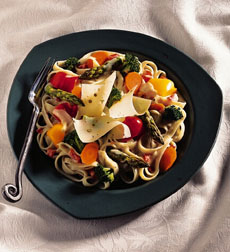Ingredients For 10-12 Tartlets
Press-In-Pan Olive Oil Pastry Crust
1-1/2 cups all-purpose flour
1/4 cup granulated sugar
1/2 teaspoon salt
1/2 cup olive oil
1 tablespoon lemon juice
1-2 tablespoons water
Matcha Tapioca
1/2 cup small tapioca pearls
2-1/2 cups vanilla coconut milk beverage, plain non-dairy milk or cow’s milk
1/3 cup granulated sugar
1 tablespoon cornstarch
1 tablespoon arrowroot powder
1 teaspoon matcha powder
1/4 teaspoon salt
2 tablespoons non-dairy margarine or butter
1 teaspoon vanilla extract
To Finish
4-5 clementines, peeled and segmented
Garnish: fresh mint leaves (optional)
Preparation
1. PREHEAT oven to 375°F; lightly grease 10-12 three-inch tartlet molds.
2. MAKE crust: Mix together the flour, sugar and salt in a large bowl. Add the olive oil and lemon juice, stirring thoroughly to incorporate. Drizzle in the water very slowly, adding just enough to bring the dough together without making it wet or sticky.
3. BREAK off 2-3 tablespoons of dough for each tartlet and press it evenly across the bottoms and up the sides of the molds. Make sure there aren’t especially thick edges left around the base, so that the entire crust cooks evenly.
4. BAKE for 10-15 minutes, turning the pan around halfway through the process to ensure even baking, until golden brown all over. Let cool completely before popping the shells out of the molds.
5. MAKE the tapioca: Pour 2 cups of very hot water over the pearls and allow them to soak for 2-3 hours. This will soften them and prevent hard centers from remaining after cooking. Rinse with cold water and thoroughly drain.
6. PLACE the soaked pearls in a medium saucepan along with the milk. Whisk together the sugar, matcha, cornstarch and arrowroot in a separate bowl and break up any clumps of matcha.
7. ADD mixture to the pot and place over medium heat on the stove. Allow the mixture to come up to a boil, whisking periodically. Be sure to scrape along the sides and bottom to prevent sticking and burning. Once the mixture bubbles vigorously for a full minute, turn off the heat; then add the butter/margarine and vanilla extract. Stir until the butter/margarine has completely melted; then distribute the mixture between the baked tart shells, filling them to the top.
8. COOL the tapioca filling fully; then top with clementine segments and optional mint leaves (if the leaves are large, cut into a chiffonade [finely cut strips]). Serve at room temperature or chill for 2 hours.
CLEMENTINES ARE NOT ORANGES
There are three basic citrus types—citron, mandarin and pummelo—from which all modern citrus derives via hybrids or backcrosses.
While they look like small oranges and are often called “mandarin oranges,” mandarins are a separate species that includes the clementine, mineola (red tangelo), murcott (also called honey tangerine), tangelo, temple and satsuma, among others.
Oranges are from the order Sapindales, family Rutaceae, genus Citrus and species C. × sinensis.
Mandarins are from the order Sapindales, family Rutaceae, genus Citrus and species C. reticulata (clementines are C. clementina).
Clementines alone have numerous sub-species, some more commercial than others (the Clemenules Clementine is the largest commercially grown variety). “Cuties” are a marketing name for clementine mandarins generally sold before Christmas. The same fruit is called a murcott or tango mandarin after the holidays. Why ask why?
More Confusion
Mandarins are also called loose-skin oranges—a usage which is both unfortunate and confusing given the numerous, highly distinctive differences between the two genuses. According to the experts at U.C. Davis:
In the U.S., where the name tangerine first came into common usage, mandarin (or “mandarin orange”) and tangerine are used more or less interchangeably to designate the whole group. Since mandarin is the older and much more widely employed name, its use is clearly preferable.
The term “tangerine” was coined for brightly-colored sweet mandarins that were originally shipped out of the port of Tangiers, Morocco to Florida in the late 1800s; the term stuck.
Presumably because of the orange-red color of the Dancy variety, which originated in Florida and was introduced in the markets as the Dancy tangerine, horticulturists have tended to restrict the use of the term tangerine to the mandarins of similar deep color. However, this is a usage of convenience only and the tangerines do not comprise a group of natural significance.
The mandarin probably originated in northeastern India, home of the Indian wild mandarin, Citrus indica Tan. As with all agriculatural products, many hybrids followed. The King and Kunenbo mandarins, for example, originated in Indo-China and the Satsuma mandarin originated in Japan. The Mediterranean mandarin is believed to have been cultivated in Italy.
The mandarin reached the Mediterranean basin in the early 1800s, and about 1825 in Florida. Thanks to the University of California Davis for providing this information. You can read more here.
|








